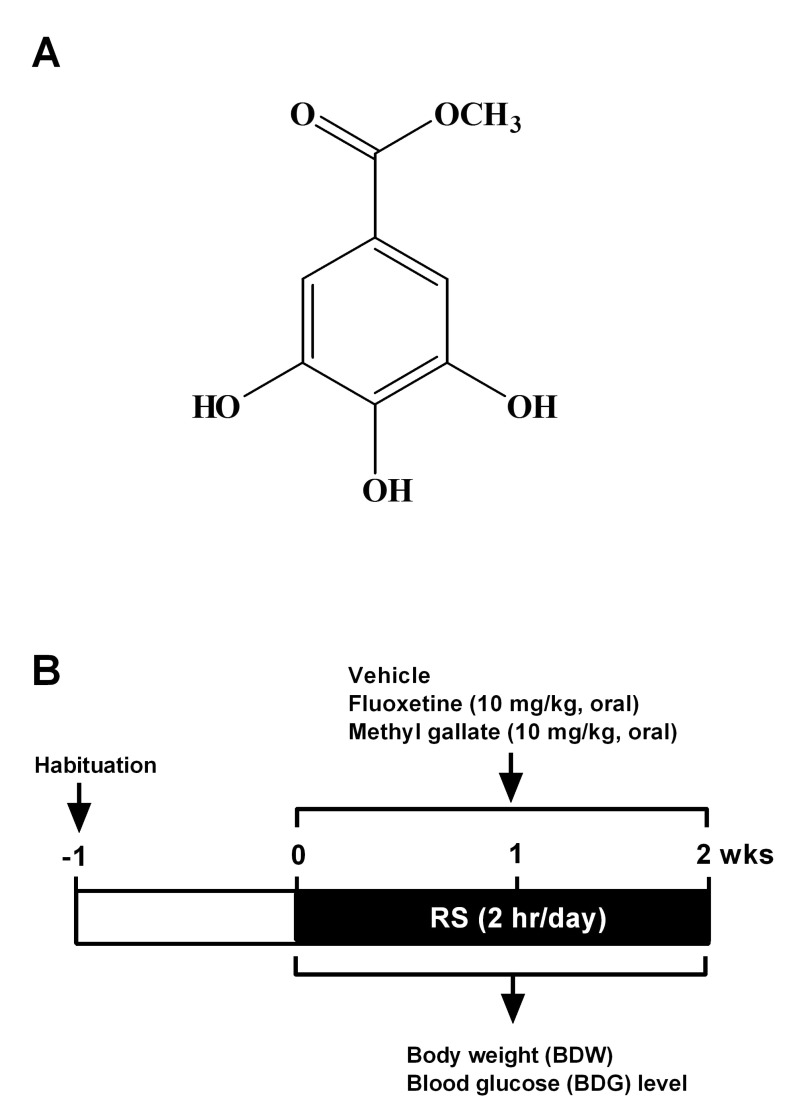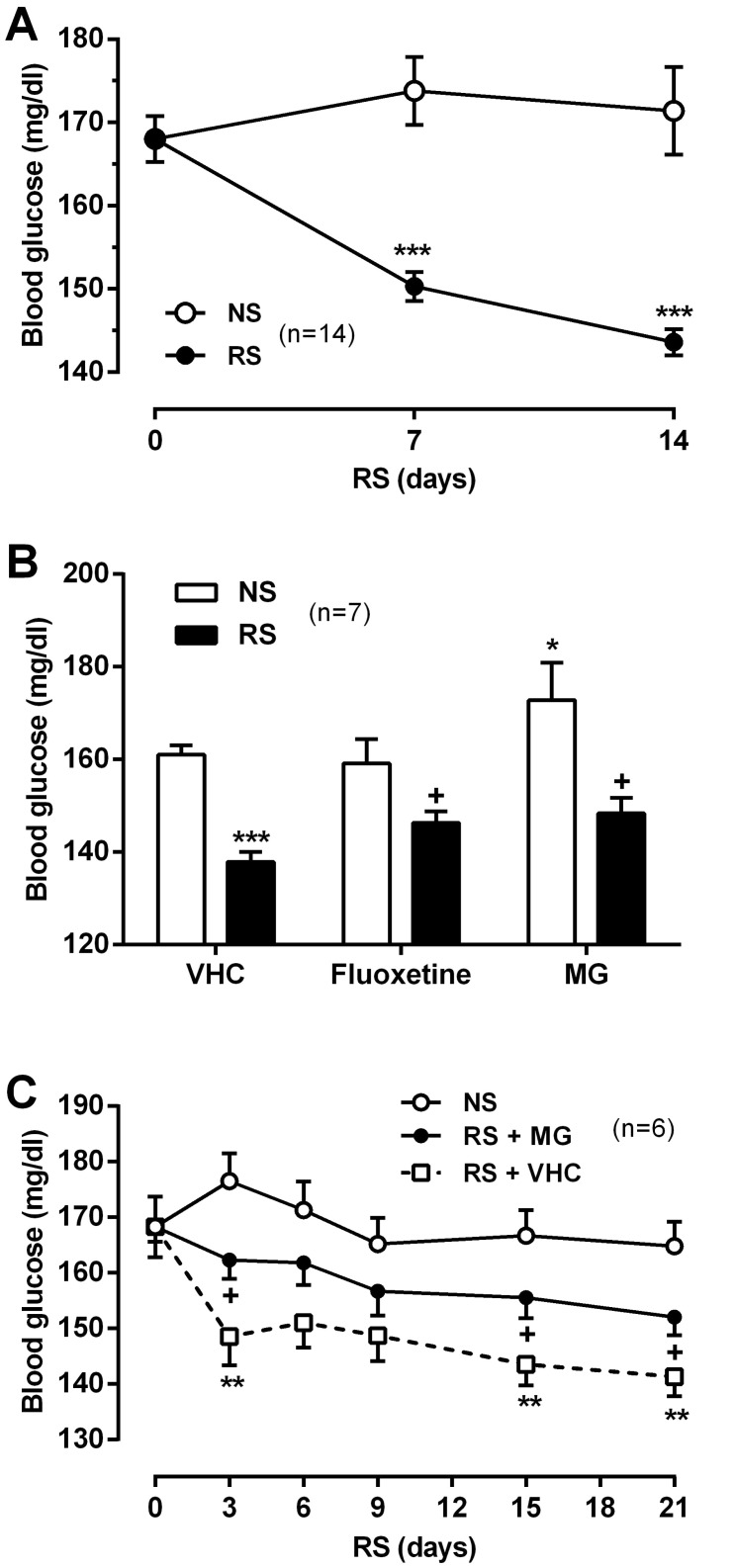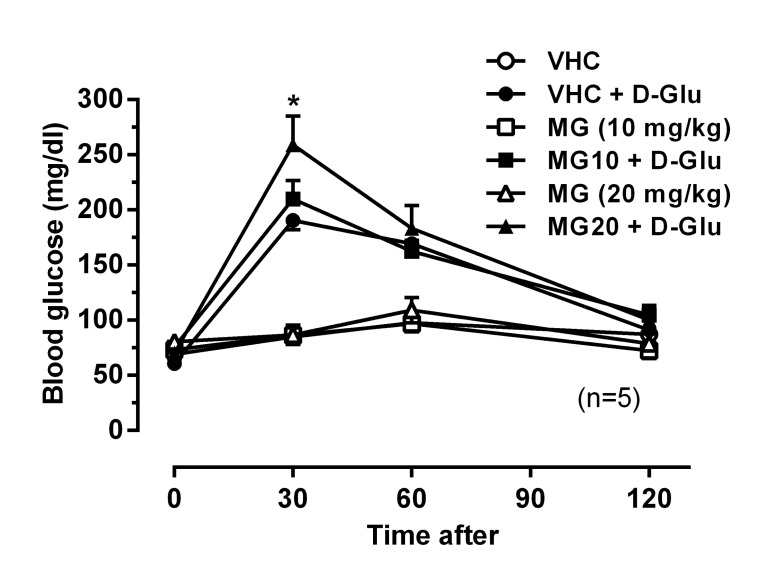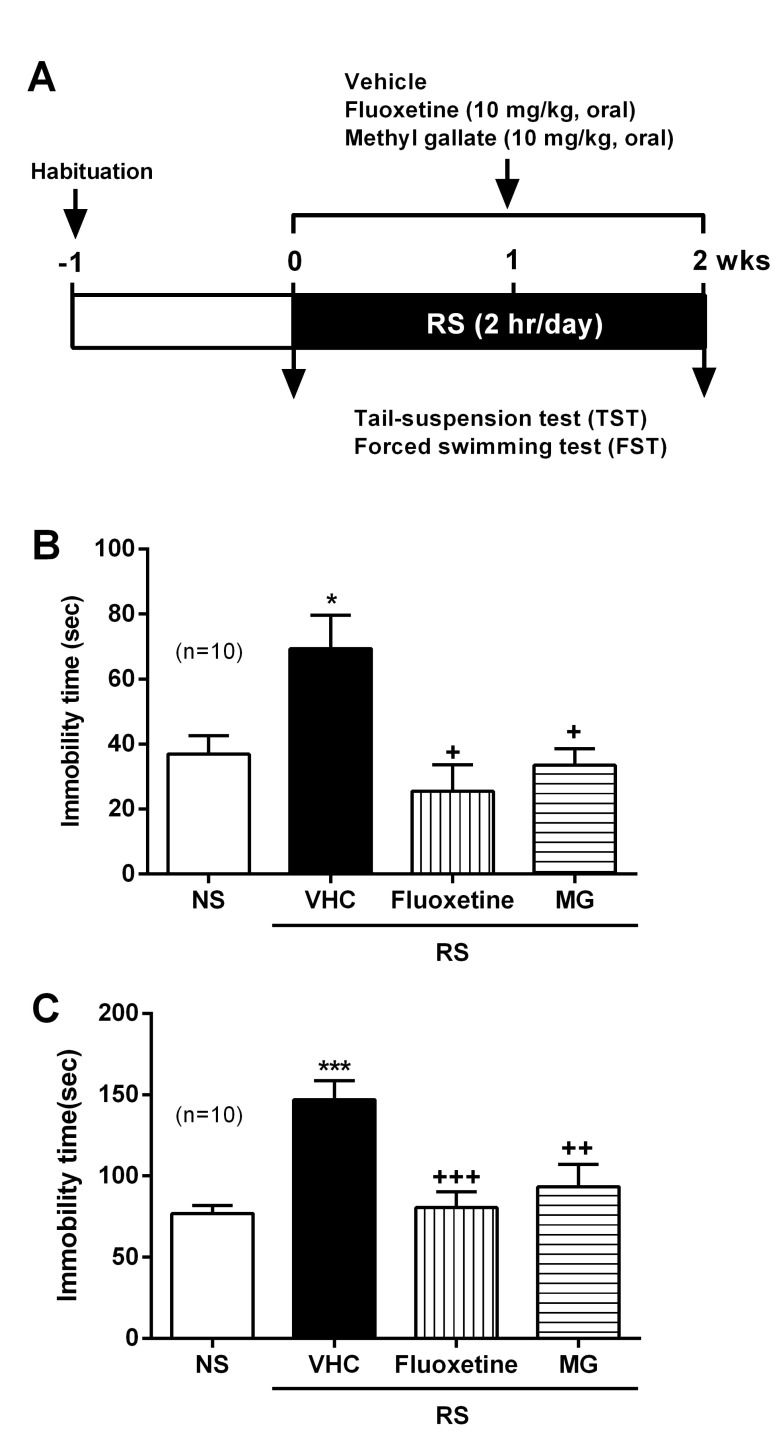Korean J Physiol Pharmacol.
2013 Oct;17(5):441-446. 10.4196/kjpp.2013.17.5.441.
Anti-Depressant Like Effect of Methyl Gallate Isolated from Acer barbinerve in Mice
- Affiliations
-
- 1Department of Pharmacology, College of Medicine, Dankook University, Cheonan 330-714, Korea. leejking@dankook.ac.kr
- KMID: 1500240
- DOI: http://doi.org/10.4196/kjpp.2013.17.5.441
Abstract
- In the present study, the anti-depressant like effect of methyl gallate (MG) isolated from the stem bark of Acer barbinerve was examined in ICR mice. Body weight (BDW) and blood glucose (BDG) levels significantly decreased in the repeated restraint stress (RRS) group (2 h/day for 14 days) compared to the no stress (NS) group. To examine the effect of MG on RS-induced BDW loss and hypoglycemia, MG (10 mg/kg) and the anti-depressant fluoxetine (10 mg/kg) were administered daily for 14 days. Orally administered MG and fluoxetine significantly attenuated the RS-induced BDW loss and hypoglycemia. Interestingly, MG administered mice showed increased BDG levels in the normal and glucose feeding condition. Chronic RS-subjected mice showed immobilized and depressed behaviors. The effect of MG on the depressed behaviors was evaluated using the tail-suspension test (TST) and the forced swimming test (FST). In both tests, RS-induced immobilized behaviors were significantly reversed in MG and fluoxetine administered groups. Taken together, MG significantly attenuated the RS-induced BDW loss, hypoglycemia, and depressed behaviors. Considering that decreased BDG levels (hypoglycemia) can cause depression, MG may exert its anti-depressant like effect by preventing hypoglycemia. Our results suggest that MG isolated from A. barbinerve can exert anti-depressant like effect, and could be used as a new and natural anti-depressant therapy.
MeSH Terms
Figure
Reference
-
1. Alkadhi KA. Chronic psychosocial stress exposes Alzheimer's disease phenotype in a novel at-risk model. Front Biosci (Elite Ed). 2012; 4:214–229. PMID: 22201866.
Article2. Cyr NE, Earle K, Tam C, Romero LM. The effect of chronic psychological stress on corticosterone, plasma metabolites, and immune responsiveness in European starlings. Gen Comp Endocrinol. 2007; 154:59–66. PMID: 17681504.
Article3. Schmidt MV, Sterlemann V, Müller MB. Chronic stress and individual vulnerability. Ann N Y Acad Sci. 2008; 1148:174–183. PMID: 19120107.
Article4. Pittenger C, Duman RS. Stress, depression, and neuroplasticity: a convergence of mechanisms. Neuropsychopharmacology. 2008; 33:88–109. PMID: 17851537.
Article5. Berton O, McClung CA, Dileone RJ, Krishnan V, Renthal W, Russo SJ, Graham D, Tsankova NM, Bolanos CA, Rios M, Monteggia LM, Self DW, Nestler EJ. Essential role of BDNF in the mesolimbic dopamine pathway in social defeat stress. Science. 2006; 311:864–868. PMID: 16469931.
Article6. Greene J, Banasr M, Lee B, Warner-Schmidt J, Duman RS. Vascular endothelial growth factor signaling is required for the behavioral actions of antidepressant treatment: pharmacological and cellular characterization. Neuropsychopharmacology. 2009; 34:2459–2468. PMID: 19553916.
Article7. Kim KS, Han PL. Optimization of chronic stress paradigms using anxiety- and depression-like behavioral parameters. J Neurosci Res. 2006; 83:497–507. PMID: 16416425.
Article8. Kim KS, Kwon HJ, Baek IS, Han PL. Repeated short-term (2 h×14 d) emotional stress induces lasting depression-like behavior in mice. Exp Neurobiol. 2012; 21:16–22. PMID: 22438675.9. Willner P. Chronic mild stress (CMS) revisited: consistency and behavioural-neurobiological concordance in the effects of CMS. Neuropsychobiology. 2005; 52:90–110. PMID: 16037678.
Article10. Crispo JA, Piché M, Ansell DR, Eibl JK, Tai IT, Kumar A, Ross GM, Tai TC. Protective effects of methyl gallate on H2O2-induced apoptosis in PC12 cells. Biochem Biophys Res Commun. 2010; 393:773–778. PMID: 20171161.
Article11. Hsieh TJ, Liu TZ, Chia YC, Chern CL, Lu FJ, Chuang MC, Mau SY, Chen SH, Syu YH, Chen CH. Protective effect of methyl gallate from Toona sinensis (Meliaceae) against hydrogen peroxide-induced oxidative stress and DNA damage in MDCK cells. Food Chem Toxicol. 2004; 42:843–850. PMID: 15046831.
Article12. Kang MS, Jang HS, Oh JS, Yang KH, Choi NK, Lim HS, Kim SM. Effects of methyl gallate and gallic acid on the production of inflammatory mediators interleukin-6 and interleukin-8 by oral epithelial cells stimulated with Fusobacterium nucleatum. J Microbiol. 2009; 47:760–767. PMID: 20127471.
Article13. Choi JG, Kang OH, Lee YS, Oh YC, Chae HS, Jang HJ, Shin DW, Kwon DY. Antibacterial activity of methyl gallate isolated from Galla Rhois or carvacrol combined with nalidixic acid against nalidixic acid resistant bacteria. Molecules. 2009; 14:1773–1780. PMID: 19471197.
Article14. Kang MS, Oh JS, Kang IC, Hong SJ, Choi CH. Inhibitory effect of methyl gallate and gallic acid on oral bacteria. J Microbiol. 2008; 46:744–750. PMID: 19107406.
Article15. Lee H, Lee H, Kwon Y, Lee JH, Kim J, Shin MK, Kim SH, Bae H. Methyl gallate exhibits potent antitumor activities by inhibiting tumor infiltration of CD4+CD25+ regulatory T cells. J Immunol. 2010; 185:6698–6705. PMID: 21048105.16. Lee SH, Kim JK, Kim DW, Hwang HS, Eum WS, Park J, Han KH, Oh JS, Choi SY. Antitumor activity of methyl gallate by inhibition of focal adhesion formation and Akt phosphorylation in glioma cells. Biochim Biophys Acta. 2013; 1830:4017–4029. PMID: 23562553.
Article17. Park SH, Sim YB, Han PL, Lee JK, Suh HW. Antidepressant-like effect of kaempferol and quercitirin, isolated from Opuntia ficus-indica var. saboten. Exp Neurobiol. 2010; 19:30–38. PMID: 22110339.
Article18. Sim YB, Park SH, Kang YJ, Kim SS, Kim CH, Kim SJ, Jung JS, Ryu OH, Choi MG, Choi SS, Suh HW. Effect of cholera toxin administered supraspinally or spinally on the blood glucose level in pain and d-glucose fed animal models. Korean J Physiol Pharmacol. 2013; 17:163–167. PMID: 23626479.
Article19. Pedersen WA, Culmsee C, Ziegler D, Herman JP, Mattson MP. Aberrant stress response associated with severe hypoglycemia in a transgenic mouse model of Alzheimer's disease. J Mol Neurosci. 1999; 13:159–165. PMID: 10691302.
Article20. Zhou J, Shi MX, Mitchell TD, Smagin GN, Thomas SR, Ryan DH, Harris RB. Changes in rat adipocyte and liver glucose metabolism following repeated restraint stress. Exp Biol Med (Maywood). 2001; 226:312–319. PMID: 11368423.
Article21. Ozcan U, Yilmaz E, Ozcan L, Furuhashi M, Vaillancourt E, Smith RO, Görgün CZ, Hotamisligil GS. Chemical chaperones reduce ER stress and restore glucose homeostasis in a mouse model of type 2 diabetes. Science. 2006; 313:1137–1140. PMID: 16931765.
Article22. Sim YB, Park SH, Kang YJ, Kim SM, Lee JK, Jung JS, Suh HW. The regulation of blood glucose level in physical and emotional stress models: possible involvement of adrenergic and glucocorticoid systems. Arch Pharm Res. 2010; 33:1679–1683. PMID: 21052944.
Article23. Tsoi B, He RR, Yang DH, Li YF, Li XD, Li WX, Abe K, Kurihara H. Carnosine ameliorates stress-induced glucose metabolism disorder in restrained mice. J Pharmacol Sci. 2011; 117:223–229. PMID: 22123261.
Article24. Park MJ, Yoo SW, Choe BS, Dantzer R, Freund GG. Acute hypoglycemia causes depressive-like behaviors in mice. Metabolism. 2012; 61:229–236. PMID: 21820138.
Article25. Ribeiro-de-Oliveira A, Guerra RM, Fóscolo RB, Marubayashi U, Reis AM, Coimbra CC. Bromocriptine-induced dissociation of hyperglycemia and prolactin response to restraint. Pharmacol Biochem Behav. 2001; 68:229–233. PMID: 11267627.
Article26. Bates HE, Kiraly MA, Yue JT, Goche Montes D, Elliott ME, Riddell MC, Matthews SG, Vranic M. Recurrent intermittent restraint delays fed and fasting hyperglycemia and improves glucose return to baseline levels during glucose tolerance tests in the zucker diabetic fatty rat--role of food intake and corticosterone. Metabolism. 2007; 56:1065–1075. PMID: 17618951.
Article27. Kainuma E, Watanabe M, Tomiyama-Miyaji C, Inoue M, Kuwano Y, Ren H, Abo T. Association of glucocorticoid with stress-induced modulation of body temperature, blood glucose and innate immunity. Psychoneuroendocrinology. 2009; 34:1459–1468. PMID: 19493627.
Article28. Piroli GG, Grillo CA, Charron MJ, McEwen BS, Reagan LP. Biphasic effects of stress upon GLUT8 glucose transporter expression and trafficking in the diabetic rat hippocampus. Brain Res. 2004; 1006:28–35. PMID: 15047021.
Article29. Lee CY. Chronic restraint stress induces intestinal inflammation and alters the expression of hexose and lipid transporters. Clin Exp Pharmacol Physiol. 2013; 40:385–391. PMID: 23586523.
Article
- Full Text Links
- Actions
-
Cited
- CITED
-
- Close
- Share
- Similar articles
-
- Immunotherapy with methyl gallate, an inhibitor of Treg cell migration, enhances the anti-cancer effect of cisplatin therapy
- Analysis of α-Glucosidase Inhibitory Constituents from Acer tegmentosum Using LC-QTOF MS/MS And Molecular Networking
- Cytotoxic Effects of Gallic Acid and its Derivatives Against HIV-I-infected Microglia
- Antimicrobial Activity of Methyl Gallate isolated from the Leaves of Glochidion superbum Against Hospital Isolates of Methicillin Resistant Staphylococcus aureus
- Acer tegmentosum Maxim Prevents Bone Loss by Inhibiting Osteoclastogenesis and Promoting Osteoblast Mineralization in Ovariectomized Mice






